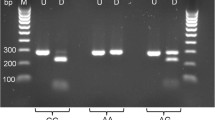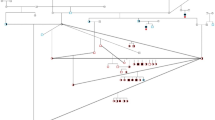Abstract
Degenerative myelopathy (DM) is a late-onset, slowly progressive degeneration of spinal cord white matter which is reported primarily in large breed dogs. The missense mutation SOD1:c.118G>A is associated with this pathology in several dog breeds, including the German Shepherd Dog (GSD). The aims of the present study were to develop a tool for the rapid screening of the SOD1 mutation site in dogs and to evaluate the association of the polymorphism with DM in the German Shepherd breed. Two different techniques were compared: a minisequencing test and a real-time pcr allelic discrimination assay. Both approaches resulted effective and efficient. A sample of 47 dogs were examined. Ten subjects presented the symptoms of the illness; for one of them the diagnosis was confirmed by postmortem investigations and it resulted to be an A/A homozygote. In another clinically suspected dog, heterozygote A/G, the histopathological examination of the medulla showed moderate axon and myelin degenerative changes. GSD shows a frequency of the mutant allele equal to 0.17, quite high being a high-risk allele. Because canine DM has a late onset in adulthood and homozygous mutant dogs are likely as fertile as other genotypes, the natural selection is mild and the mutant allele may reach high frequencies. A diagnostic test, easy to implement, may contribute to control the gene diffusion in populations. The SOD1:c.118G>A mutation could be a useful marker for breeding strategies intending to reduce the incidence of DM.




Similar content being viewed by others
References
Coates JR, Wininger FA (2010) Canine degenerative myelopathy. Vet Clin North Am Small Anim Pract 40:929–950
March PA, Coates JR, Abyad R et al (2009) Degenerative myelopathy in 18 Pembroke Welsh corgi dogs. Vet Pathol 46:241–250
Awano T, Johnson GS, Wade C et al (2009) Genome-wide association analysis reveals a SOD1 missense mutation canine degenerative myelopathy that resembles amyotrophic lateral sclerosis. Proc Natl Acad Sci 106:2794–2799
Jonsson PA, Ernhill K, Andersen PM et al (2004) Minute quantities of misfolded mutant superoxide dismutase-1 cause amyotrophic lateral sclerosis. Brain 127:73–88
Shaw BF, Durazo A, Nersissian AM et al (2006) Local unfolding in a destabilized, pathogenic variant of superoxide dismutase 1 observed with H/D exchange and mass spectrometry. J Biol Chem 281:18167–18176
Rakhit R, Chakrabartty A (2006) Structure, folding, and misfolding of Cu, Zn superoxide dismutase in amyotrophic lateral sclerosis. Biochim Biophys Acta 1762:1025–1037
Marucci G, Morandi L, Bartolomei I et al (2007) Amyotrophic lateral sclerosis with mutation of the Cu/Zn superoxide dismutase gene (SOD1) in a patient with Down syndrome. Neuromuscul Disord 17:673–676
Rosen DR, Siddique T, Patterson D et al (1993) Mutations in Cu/Zn superoxide dismutase gene are associated with familial amyotrophic lateral sclerosis. Nature 362:59–62
Pasinelli P, Brown RH (2006) Molecular biology of amyotrophic lateral sclerosis: insights from genetics. Nat Rev Neurosci 7:710–723
Stopińska K, Grzybowski T, Malyarchuk BA et al (2006) Optimization of the Y831C mutation detection in human DNA polymerase gamma by allelic discrimination assay. Acta Biochim Pol 53:591–595
Thompson JD, Higgins DG, Gibson TJ (1994) Clustal W: improving the sensitivity of progressive multiple sequence alignment through sequence weighting, position-specific gap penalties and weight matrix choice. Nucleic Acids Res 22:4673–4680
Chang HS, Kamishina H, Mizukami K, et al.(2013) Genotyping assays for the canine degenerative myelopathy-associated c.118G>A (p.E40 K) Mutation of the SOD1 gene using conventional and real-time PCR methods: a high prevalence in the Pembroke Welsh corgi breed in Japan. J Vet Med Sci (Epub ahead of print)
Wininger FA, Zeng R, Johnson GS et al (2011) Degenerative myelopathy in a Bernese mountain dog with a novel SOD1 missense mutation. J Vet Intern Med 25:1166–1170
Zeng R, Coates JR, Hansen L, et al.(2012) The distributions of two SOD1 missense mutations in the pet dog population and their association with canine degenerative myelopathy, a model for amyotrophic lateral sclerosis. American Society of Human Genetics (ASHG)’s 62nd Annual Meeting, 6–10, November 2012 San Francisco, CA
Acknowledgments
The authors thank Alessandra Sereno for technical support.
Conflict of interest
The authors declared no potential conflicts of interest with respect to the research, authorship, and/or publication of this article.
Author information
Authors and Affiliations
Corresponding author
Additional information
Maria Teresa Capucchio and Veronica Spalenza have contributed equally to this work.
Rights and permissions
About this article
Cite this article
Capucchio, M.T., Spalenza, V., Biasibetti, E. et al. Degenerative myelopathy in German Shepherd Dog: comparison of two molecular assays for the identification of the SOD1:c.118G>A mutation. Mol Biol Rep 41, 665–670 (2014). https://doi.org/10.1007/s11033-013-2904-9
Received:
Accepted:
Published:
Issue Date:
DOI: https://doi.org/10.1007/s11033-013-2904-9




